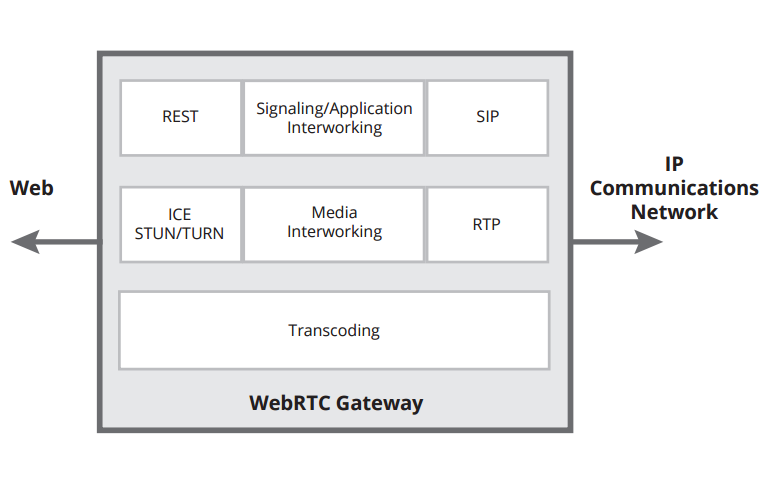A WebRTC gateway is a special-purpose device that bridges conventional IP communications networks with the open ecosystem of the Internet. WebRTC (Web Real-Time Communications) is a standard for embedding interactive communications capabilities––voice, video, chat––directly into a Web browser. Prior to WebRTC, developers relied on proprietary plug-ins or custom browser extensions to enable browser-based communications. WebRTC enables better user experiences and simplifies client administration by eliminating vendor specific, browser-specific plug-ins. Many popular browsers including Google (Chrome™), Mozilla® (Firefox®) and Opera™ now support WebRTC. With WebRTC, communications service providers and enterprise IT organizations can easily extend real-time communications to any browser-enabled device (PC, smartphone, or tablet) over any IP network (public or private, wired or wireless).
What is a WebRTC Gateway: Functions
WebRTC provides a simple way to implement peer-to-peer communications between browsers. The WebRTC standards focus primarily on the media plane. Signaling plane functions––session setup and management––are left to the application developer. New server side elements are required to interwork dissimilar transport and signaling methods employed in the Web and IP communications domains.
The WebRTC gateway sits at the intersection of a conventional IP-based communications network and the Internet. It bridges the Web and traditional telecom worlds, providing signaling interworking, media interworking and transcoding, and application interworking functions. The WebRTC gateway can be delivered in the form of a turn-key appliance or a software-based solution that runs industry-standard servers (typically virtualized x86 platforms running some version of Linux).
Many WebRTC gateways provide REST APIs that streamline application development. REST (REpresentational State Transfer) is a simple stateless application architecture that is widely used by Web developers. The REST APIs provided by WebRTC gateways allow ordinary Web developers, who aren’t necessarily versed in telecommunications, to embed real-time communications capabilities directly into web-based applications––quickly, easily and cost-effectively.
WebRTC Gateway Applications
WebRTC gateways enable a wide variety of applications for enterprise IT organizations, service providers, system integrators and software developers.
- Mobile clients for enterprises – businesses can extend corporate communications services to smartphone or tablet users as part of BYOD programs or fixed-mobile convergence initiatives. IT organizations can eliminate the expense and administrative complexity of proprietary UC clients by extending enterprise communications capabilities directly to the browser. And they can reduce international mobile roaming fees and calling costs by enabling Wi-Fi calling.
- Service provider RCS and OTT clients – communications service providers can implement Rich Communication Services (RCS) clients and Over-the-Top (OTT) clients. Many communications service providers are looking to RCS and OTT services to improve margins, combat competitive threats, extend service reach and drive additional traffic onto home networks.
- Communications-enabled Web apps – businesses can add voice, video or chat to customer-facing Web sites or mobile apps to improve customer interactions, reduce Website abandonment, and increase customer loyalty and revenue.
- On-line meetings and conferencing services – enterprises and service providers can offer lightweight browser-based audio and video communications services for on-line meetings, presentations, or Webinars. Enterprises can improve collaboration and customer interactions while eliminating unnecessary travel expenses. Service providers can add value added, high-margin services to their solution portfolios.
- Communications-enabled business processes – corporate IT organizations can integrate real-time communications capabilities directly into enterprise applications and business processes to streamline workflows, increase productivity and improve decision making. Service providers, software vendors and system integrators can embed real-time communications directly into vertical applications to deliver immersive user experiences.


